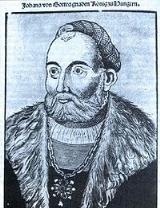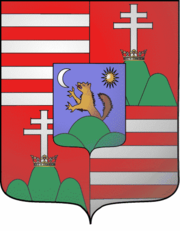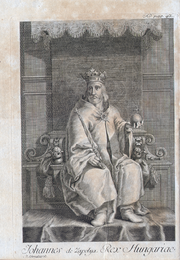
John Zápolya
Encyclopedia

Ferdinand I, Holy Roman Emperor
Ferdinand I was Holy Roman Emperor from 1558 and king of Bohemia and Hungary from 1526 until his death. Before his accession, he ruled the Austrian hereditary lands of the Habsburgs in the name of his elder brother, Charles V, Holy Roman Emperor.The key events during his reign were the contest...
, who also claimed the title King of Hungary between 1526 and 1540. He was the voivode of Transylvania
Transylvania
Transylvania is a historical region in the central part of Romania. Bounded on the east and south by the Carpathian mountain range, historical Transylvania extended in the west to the Apuseni Mountains; however, the term sometimes encompasses not only Transylvania proper, but also the historical...
before his coronation.
Biography
He was born at Castle of SzepesSpiš Castle
The ruins of Spiš Castle in eastern Slovakia form one of the largest castle sites in Central Europe. The castle is situated above the town of Spišské Podhradie and the village of Žehra, in the region known as Spiš...
in Upper Hungary (now known as Spiš Castle in Slovakia). Vladislaus II of Bohemia and Hungary
Vladislaus II of Bohemia and Hungary
Vladislaus II, also known as Ladislaus Jagiellon ; was King of Bohemia from 1471 and King of Hungary from 1490 until his death in 1516...
wrote many letters with the same text to many of the Hungarian nobility in the year 1490, before he became the king of Hungary. He wrote that -Beatrice of Naples
Beatrice of Naples
Beatrice of Naples was the daughter of Ferdinand I of Naples and Isabella of Taranto. She was queen consort to both Matthias Corvinus of Hungary and Vladislaus II of Bohemia and Hungary so she was Queen of Hungary and Bohemia.-Biography:Beatrice received a good education at her father's court in...
had written to him that- Matthias Corvinus and Beatrice had decided that Stephen Zápolya, the father of John Zápolya should become the next duke of Austria after Matthias Corvinus. John began his public career in 1505 as a member of the Diet of Rákos; it was upon his motion that the Diet voted that no foreign prince would ever again be elected king of Hungary after the death of King Vladislaus II. Appointed voivode (governor) of Transylvania in 1511 John Zápolya used the turbulent times of his era to enrich himself and secured a power base in Transylvania. When he was tasked with defeating the peasant rebellion of 1514 led by György Dózsa
György Dózsa
György Dózsa was a Székely Hungarian man-at-arms from Transylvania, Kingdom of Hungary who led a peasants' revolt against the kingdom's landed nobility...
he used extreme cruelty. On 29 August 1526, the army of Sultan Suleyman I
Suleiman the Magnificent
Suleiman I was the tenth and longest-reigning Sultan of the Ottoman Empire, from 1520 to his death in 1566. He is known in the West as Suleiman the Magnificent and in the East, as "The Lawgiver" , for his complete reconstruction of the Ottoman legal system...
of the Ottoman Empire
Ottoman Empire
The Ottoman EmpireIt was usually referred to as the "Ottoman Empire", the "Turkish Empire", the "Ottoman Caliphate" or more commonly "Turkey" by its contemporaries...
inflicted a decisive defeat on the Hungarian forces at Mohács
Battle of Mohács
The Battle of Mohács was fought on August 29, 1526 near Mohács, Hungary. In the battle, forces of the Kingdom of Hungary led by King Louis II of Hungary and Bohemia were defeated by forces of the Ottoman Empire led by Sultan Suleiman the Magnificent....
. Zápolya was en route to the battlefield with his sizable army but did not participate in the battle for unknown reasons. The youthful King Louis II of Hungary and Bohemia
Louis II of Hungary and Bohemia
Louis II was King of Hungary, Bohemia and Croatia from 1516 to 1526.- Early life :Louis was the son of Ladislaus II Jagiellon and his third wife, Anne de Foix....
fell in battle, as did many of his soldiers. The Ottomans proceeded to invest and ransack the royal capital of Buda
Buda
For detailed information see: History of Buda CastleBuda is the western part of the Hungarian capital Budapest on the west bank of the Danube. The name Buda takes its name from the name of Bleda the Hun ruler, whose name is also Buda in Hungarian.Buda comprises about one-third of Budapest's...
and occupied Syrmia
Syrmia
Syrmia is a fertile region of the Pannonian Plain in Europe, between the Danube and Sava rivers. It is divided between Serbia in the east and Croatia in the west....
, then withdrew from Hungary. The last three months of the year were marked by a vacuum of power; political authority was in a state of collapse, yet the victors chose not to impose their rule.
Two candidates stepped into the breach. One was Zápolya, Transylvania's voivode and Hungary's most prominent aristocrat as well as commander of an intact army. The other was Archduke Ferdinand of Austria
Ferdinand I, Holy Roman Emperor
Ferdinand I was Holy Roman Emperor from 1558 and king of Bohemia and Hungary from 1526 until his death. Before his accession, he ruled the Austrian hereditary lands of the Habsburgs in the name of his elder brother, Charles V, Holy Roman Emperor.The key events during his reign were the contest...
, the late king's brother-in-law and the brother of the Holy Roman Emperor
Holy Roman Emperor
The Holy Roman Emperor is a term used by historians to denote a medieval ruler who, as German King, had also received the title of "Emperor of the Romans" from the Pope...
, Charles V
Charles V, Holy Roman Emperor
Charles V was ruler of the Holy Roman Empire from 1519 and, as Charles I, of the Spanish Empire from 1516 until his voluntary retirement and abdication in favor of his younger brother Ferdinand I and his son Philip II in 1556.As...
. Their contest for power would determine the course of Hungary's history, and that of Transylvania as well.
The majority of Hungary's ruling elite backed Zápolya, who for fifteen years had been playing a leading role in Hungarian political life. Part of the aristocracy acknowledged his leadership, and he enjoyed the enthusiastic support — not always reciprocated — of the lesser nobility. Most of his opponents succumbed at Mohács: the Hungarian branch of the Jagiellon dynasty
Jagiellon dynasty
The Jagiellonian dynasty was a royal dynasty originating from the Lithuanian House of Gediminas dynasty that reigned in Central European countries between the 14th and 16th century...
became defunct, and its pro-Habsburg
Habsburg
The House of Habsburg , also found as Hapsburg, and also known as House of Austria is one of the most important royal houses of Europe and is best known for being an origin of all of the formally elected Holy Roman Emperors between 1438 and 1740, as well as rulers of the Austrian Empire and...
following was decimated.

Ottoman Turks
The Ottoman Turks were the Turkish-speaking population of the Ottoman Empire who formed the base of the state's military and ruling classes. Reliable information about the early history of Ottoman Turks is scarce, but they take their Turkish name, Osmanlı , from the house of Osman I The Ottoman...
, although, in 1526, the promise rang empty. Hungary had been fighting the Ottomans for over a century, during which time the Holy Roman Empire
Holy Roman Empire
The Holy Roman Empire was a realm that existed from 962 to 1806 in Central Europe.It was ruled by the Holy Roman Emperor. Its character changed during the Middle Ages and the Early Modern period, when the power of the emperor gradually weakened in favour of the princes...
and the House of Habsburg had offered much encouragement but no tangible help. The likelihood of assistance was further reduced by the conflict of Ferdinand's older brother, Emperor Charles V, and King Francis I of France
Francis I of France
Francis I was King of France from 1515 until his death. During his reign, huge cultural changes took place in France and he has been called France's original Renaissance monarch...
that once again flared into open war in the summer of 1526. This circumstance led the voivode to discount the threat lurking behind the Habsburgs' candidacy: that Hungary would have to contend not only with the Ottomans, but also with an attack from the west.
Thus Zápolya took no notice of his rival's protests, nor of those voiced by the few Hungarians who rallied to Ferdinand. On 10 November 1526, Szapolyai had himself proclaimed king by the diet at Székesfehérvár
Székesfehérvár
Székesfehérvár is a city in central Hungary and is the 9th largest in the country. Located around southwest of Budapest. It is inhabited by 101,973 people , with 136,995 in the Székesfehérvár Subregion. The city is the centre of Fejér county and the regional centre of Central Transdanubia...
, and he was duly crowned the next day under the name King John I of Hungary.
Profiting from nine months of relative calm, King John I strove to restore state authority. He drew on his vast private wealth, the unconditional support of the lesser nobility, and the assistance of some aristocrats to impose his policies in domestic affairs. However, in the crucial sphere of foreign relations, success eluded him. He sought an entente with the Habsburgs, proposing to form an alliance against the Ottomans, but Archduke Ferdinand, who had himself elected king by a rump diet in Pozsony
Bratislava
Bratislava is the capital of Slovakia and, with a population of about 431,000, also the country's largest city. Bratislava is in southwestern Slovakia on both banks of the Danube River. Bordering Austria and Hungary, it is the only national capital that borders two independent countries.Bratislava...
in December 1526, rejected all attempts at reconciliation. Hungary's envoys fanned out across Europe in quest of support. Only in France did they find a positive response, but even that was ineffective since Francis I was intent not on reconciling Hungary and the Habsburgs, but on drawing Hungary into a war against Charles V and his family.
Europe's political balance underwent a major shift in the summer of 1527, when, in a somewhat unplanned operation, mercenary forces of the emperor occupied Rome
Sack of Rome (1527)
The Sack of Rome on 6 May 1527 was a military event carried out by the mutinous troops of Charles V, Holy Roman Emperor in Rome, then part of the Papal States...
and drove Pope Clement VII
Pope Clement VII
Clement VII , born Giulio di Giuliano de' Medici, was a cardinal from 1513 to 1523 and was Pope from 1523 to 1534.-Early life:...
, one of France's principal allies, to capitulate. This development freed Ferdinand — who also acquired the Bohemia
Bohemia
Bohemia is a historical region in central Europe, occupying the western two-thirds of the traditional Czech Lands. It is located in the contemporary Czech Republic with its capital in Prague...
n throne in late 1526 — from the burden of assisting his brother. By then, Ferdinand had developed a Hungarian policy that was fully in keeping with the interests of his realms. He judged that if Hungary, unable to resist the Ottomans, took action independently of Austria and Bohemia, it might well enter into an alliance with the preponderant Ottoman Empire against its western neighbours. It was therefore in the interest of the Austrian hereditary provinces and of the Bohemian crown lands that the Habsburgs gain control of Hungary, by force if necessary.
In July 1527, an army of German mercenaries invaded Hungary. The moment was well chosen, for the forces of Szapolyai were tied up in the southern counties
Comitatus (Kingdom of Hungary)
A county is the name of a type of administrative units in the Kingdom of Hungary and in Hungary from the 10th century until the present day....
, where Slavonic peasants, incited by Ferdinand, had rebelled; the revolt was led by the 'Black Man', Jovan Nenad. In one sweep, the invaders captured Buda. Szapolyai hurriedly redeployed his army, but on 27 September, near Tokaj, at the Battle of Tarcal
Battle of Tarcal
The Battle of Tarcal or Battle of Tokaj was a battle fought on 27 September 1527 between the Habsburg-German-Hungarian forces of Ferdinand I, Holy Roman Emperor and an opposing Hungarian army under the command of János Szapolyai...
, it suffered a bloody defeat.
In 1528 he escaped Hungary and dwelled in castle in Tarnów
Tarnów
Tarnów is a city in southeastern Poland with 115,341 inhabitants as of June 2009. The city has been situated in the Lesser Poland Voivodeship since 1999, but from 1975 to 1998 it was the capital of the Tarnów Voivodeship. It is a major rail junction, located on the strategic east-west connection...
in Poland
Poland
Poland , officially the Republic of Poland , is a country in Central Europe bordered by Germany to the west; the Czech Republic and Slovakia to the south; Ukraine, Belarus and Lithuania to the east; and the Baltic Sea and Kaliningrad Oblast, a Russian exclave, to the north...
, hosted by Jan Amor Tarnowski.
Szapolyai managed to get a sizable following as King of Hungary, despite the association with the Ottomans which tainted him at the time. In 1538, by the Treaty of Varad, Ferdinand was designated as Szapolyai's successor, after his death. After Zápolya's death in Szászsebes (Sebeş
Sebes
Sebeș is a city in Alba County, central Romania, southern Transylvania.-Geography:The city lies on the Mureș River valley and it straddles the Sebeș river...
), his son John II Sigismund Zápolya
John II Sigismund Zápolya
John II Sigismund Zápolya was King of Hungary from 1540 to 1570 and Prince of Transylvania from 1570–1571.-Family:The son of King John I and Isabella Jagiełło, he succeeded his father as an infant...
succeeded him as King of Hungary and an Ottoman vassal. He is also well-known among the Turks, who considered him a loyal friend of Suleiman the Magnificent
Suleiman the Magnificent
Suleiman I was the tenth and longest-reigning Sultan of the Ottoman Empire, from 1520 to his death in 1566. He is known in the West as Suleiman the Magnificent and in the East, as "The Lawgiver" , for his complete reconstruction of the Ottoman legal system...
.
Married to the Polish Princess Isabella Jagiełło he had a son John II Sigismund Szapolyai of Hungary
John II Sigismund Zápolya
John II Sigismund Zápolya was King of Hungary from 1540 to 1570 and Prince of Transylvania from 1570–1571.-Family:The son of King John I and Isabella Jagiełło, he succeeded his father as an infant...
. As dowager queen, she claimed the throne as electus rex, in order to retain it for their son, until her death in 1559. Their son John II was King of Hungary from his father's death in 1540 until 1570.

